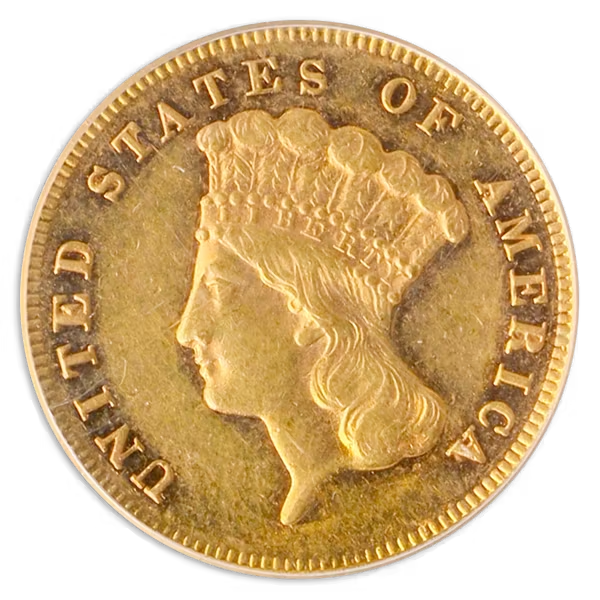The Story Behind the 1870 $3 Gold Coin: A Rarity with a Golden Legacy
Posted on — Leave a commentIntroduction
Every so often, a coin comes along that feels more like a secret than a piece of currency. The 1870 $3 Gold Coin is one of those secrets, a golden whisper from a bygone era when America was expanding westward, railroads were weaving the nation together, and gold was still king. Today, it stands as one of the most fascinating survivors of 19th-century U.S. Mint history.
railroads were weaving the nation together, and gold was still king. Today, it stands as one of the most fascinating survivors of 19th-century U.S. Mint history.
Though its face value seems modest by modern standards, the $3 gold piece represents a short-lived experiment in monetary innovation and a window into the ambitions of a young, growing nation.
The Origin of the $3 Gold Coin
The $3 gold denomination was born out of practicality, or at least, that was the idea. In 1853, Congress authorized the coin, largely to simplify the purchase of postage stamps. At the time, a sheet of 100 three-cent stamps cost exactly three dollars, so the $3 coin seemed like a convenient way to pay.
First struck in 1854, the coin was designed by Chief Engraver James Barton Longacre, the same artist behind the Indian Head cent. His $3 design features Lady Liberty wearing a feathered headdress, a distinctive nod to both classical beauty and Native American symbolism. On the reverse, a wreath of corn, wheat, cotton, and tobacco represented the country’s agricultural strength.
Unfortunately, practicality didn’t translate into popularity. Americans simply didn’t need a $3 coin in everyday commerce. Most transactions were handled in $1 or $2 increments, and the coin never circulated widely.
1870: A Year of Low Mintages and Lasting Mystique
By the time 1870 arrived, the $3 gold coin was already fading from daily use. The California Gold Rush had waned, the Mint was refining its production levels, and the nation’s monetary focus was shifting. Still, that year would produce one of the most intriguing issues in the entire $3 gold series.
The Philadelphia Mint struck only 3,500 circulation coins in 1870, while branch mints such as San Francisco produced even fewer. The 1870-S $3 gold coin, in fact, is one of the greatest rarities in all of American numismatics—believed to have only one known surviving specimen. It was likely struck for inclusion in the cornerstone of the new San Francisco Mint building, making it both legendary and nearly unattainable.
For collectors, the 1870 issue carries a dual allure: the relative scarcity of the Philadelphia strikes and the near-mythical status of the 1870-S. Even circulated examples from the Philadelphia Mint are prized, while the lone San Francisco specimen exists in a class of its own.
The Design Details That Endure
What makes the 1870 issue particularly appealing is the purity of its design. Lady Liberty’s profile is surrounded by the inscription “UNITED STATES OF AMERICA,” her hair crowned with a stylized headdress that merges Greco-Roman ideals with an American frontier spirit. It is both regal and humble, a blend that captures the optimism of the post-Civil War era.
The reverse design is equally poetic. The agricultural wreath encircling the denomination “3 DOLLARS” is a quiet tribute to the nation’s self-reliance and abundance. Every detail, from the fine engraving of the leaves to the balanced layout of the lettering, showcases Longacre’s artistry.
Each 1870 $3 gold coin was struck in .900 fine gold, weighing 5.015 grams with a diameter of 20.5 millimeters, roughly the size of a modern nickel but with a far greater story to tell.
Why Collectors Treasure the 1870 Issue
The allure of the 1870 $3 Gold Coin goes beyond its low mintage. It represents a turning point in U.S. Mint history—a time when experimentation and artistry still guided coinage design. Its rarity, beauty, and connection to one of America’s most mysterious minting stories make it a centerpiece for any advanced collection.
For collectors today, owning one is a connection to a moment when the U.S. Mint was pushing boundaries, when every engraving carried symbolic meaning, and when gold coins embodied trust and value. Its scarcity ensures it will always stand apart, a tangible piece of numismatic history that feels as personal as it does historical.
The Legacy of a Forgotten Denomination
The $3 gold piece was officially discontinued in 1889, closing a 35-year chapter of American coinage. Yet its legacy endures through pieces like the 1870 issue, coins that speak of ambition, artistry, and a restless pursuit of perfection.
For modern collectors, this coin is not just about rarity. It is about storytelling, a story told in gold, shaped by the hands of history, and preserved by generations who recognize that beauty often hides in the most unexpected corners of the past.
Are you looking for something special for your collection? For over fifty years, Blanchard has been the premier authority on high-end numismatic treasures. Give us a call today and let us help you find exactly what you’re looking for.








